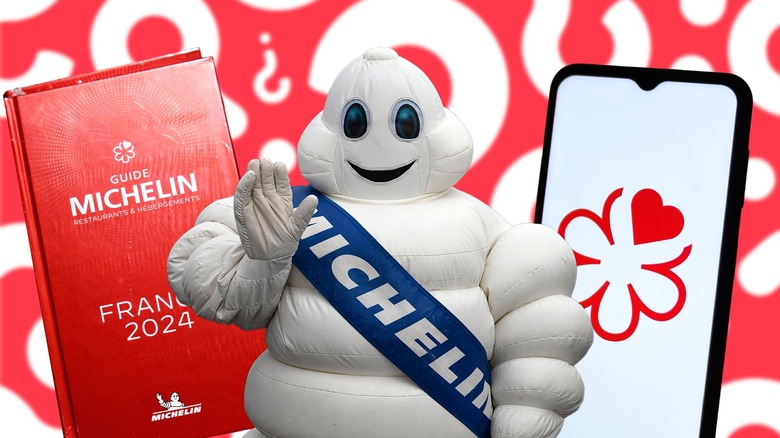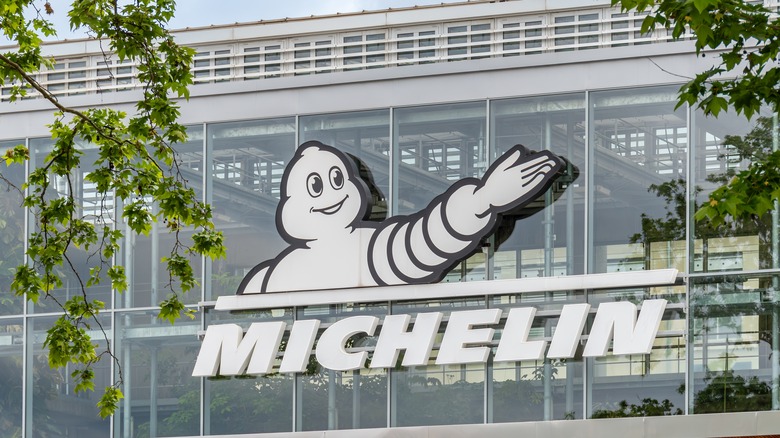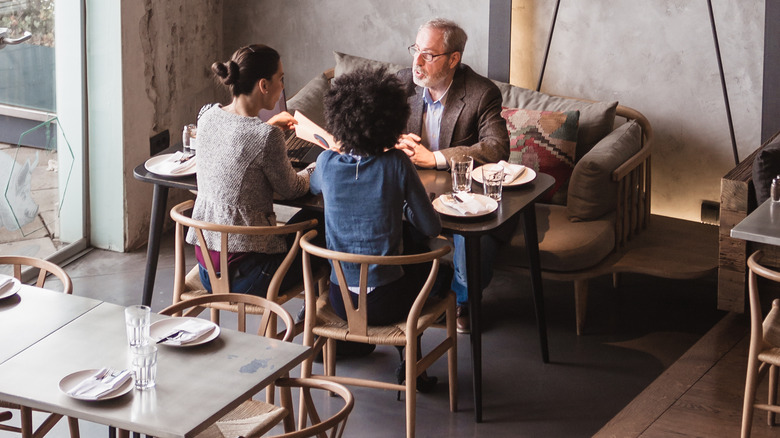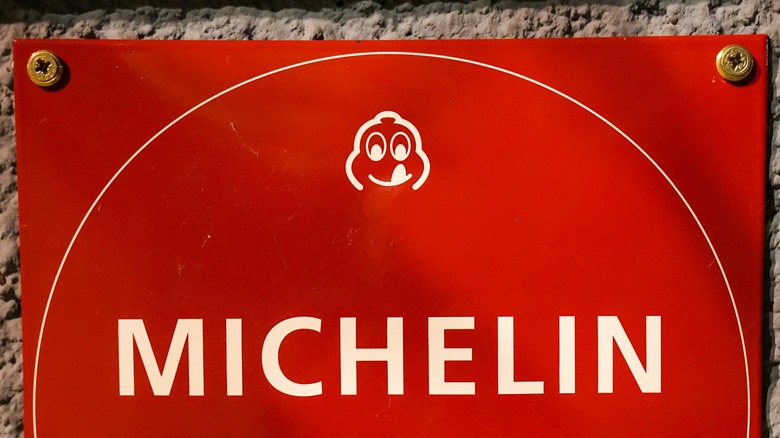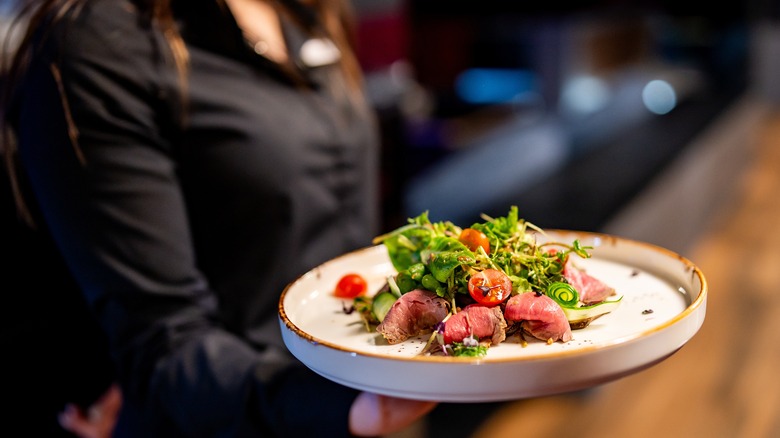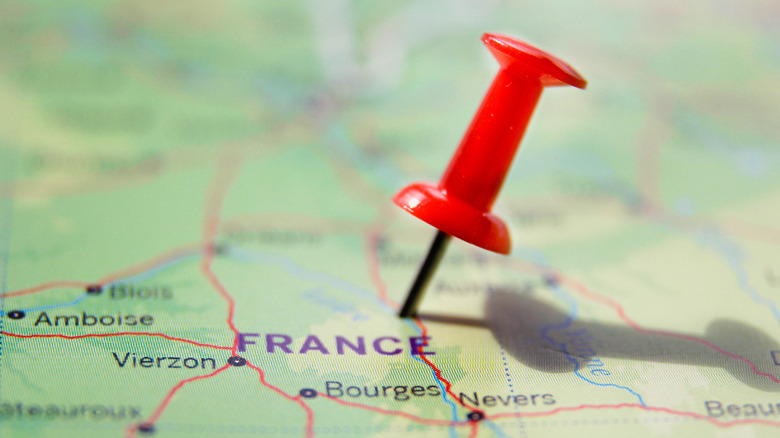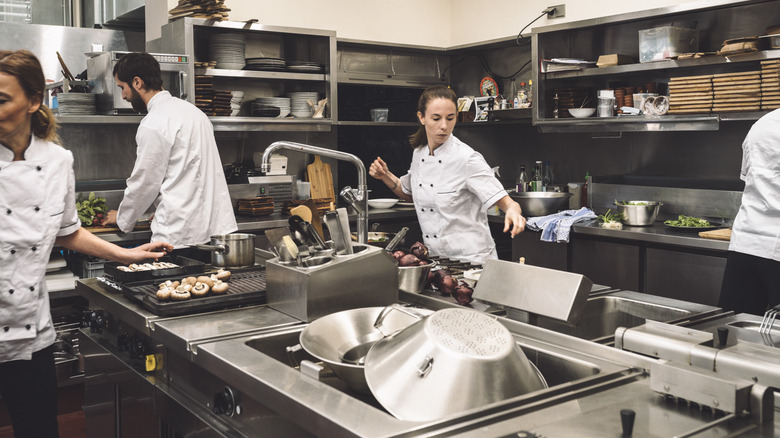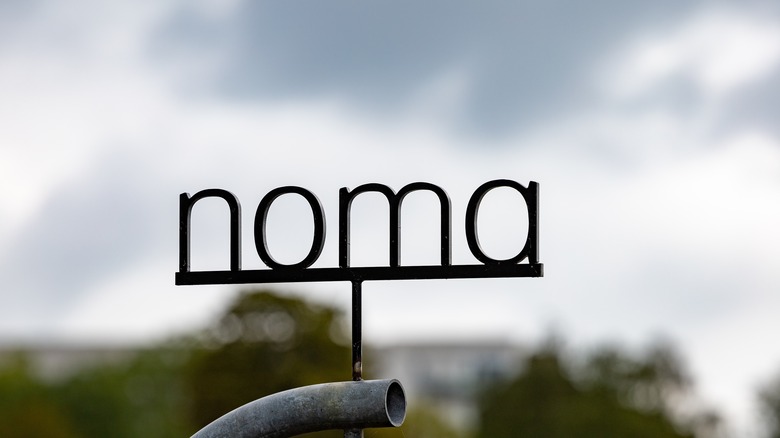12 Secrets Of The Michelin Guide All Restaurant Lovers Should Know
If you're a proud foodie, or just love scoping out great restaurants at home and abroad, you may have found yourself consulting the Michelin Guide. Recognized as the world's foremost guide to fine dining, the Michelin Guide does more than just steer us toward good eats. The organization also bestows awards — principally its coveted "stars" — on particularly impressive establishments around the world. These highly sought after recognitions are unparalleled in the industry, but how are they determined? What do they really mean? And how did the Michelin Guide come to be the institution that it is today?
As it turns out, there's more to the Guide than meets the eye. We reached out to the Michelin Guide to ask some questions about how it finds and assesses restaurants, and the organization's spokespeople sent us back some intel. We also spoke to an experienced server, sommelier, and former general manager of a Michelin-starred restaurant in Los Angeles, California, to find out some more secrets from the other side about how they obtain and retain that prestigious distinction, and what it really means for business.
Yes, it's that Michelin
Michelin Guide was, in fact, started by the Michelin tire company. That's right — the same folks who brought us the mascot that looks like a giant stack of marshmallows also brought us the world's preeminent guide to fine dining. And how did that happen? Well, it started in the late 1800s in France when the Michelin brothers, Andre and Edouard, created a free guide booklet that they distributed alongside their tires. This early guide was simply meant "to help motorists develop their trips."
In 1920, the brothers started charging for their guidebook, eliminating the advertisements and putting more emphasis on hotels and restaurants. They wanted to encourage folks to hit the road (in their car decked with Michelin tires, of course) and explore the offerings around them. More miles in the car means more tires sold!
The organization began awarding stars to noteworthy destinations in 1926, and the way it describes its star rating method to this day reflects this early connection to tires and travel. A one star restaurant is defined as "high quality cooking, worth a stop." Two stars means "excellent cooking, worth a detour," and three Michelin Stars denote "exceptional cuisine, worth a special journey." Stops, detours, and journeys all harken back to the road trip, though you might just as easily cruise to a special destination on some Firestone tires, or by train for that matter.
Michelin's inspectors operate in secret
From the start, Michelin chose to deploy anonymous "mystery diners" to inspect restaurants and hotels, presumably to avoid any accusations of influence or corruption in their supposedly objective recommendations. And also to keep restaurants on their toes. If you don't know who's reviewing you, then you can't put on a special show just for them. The company still keeps the identities of their reviewers a secret. Michelin Guide assured us that to become an inspector, individuals must be qualified with a minimum of 10 years experience in the restaurant and hotel industries, as well as a commitment to putting aside personal preference to ensure a fair assessment. You won't find any list of these super diners on its website, but they are full-time employees of the company.
Our source in the fine dining industry, who requested to remain anonymous, told us there are lots of myths about how they're being judged. There was one rumor circulating that an inspector would place a fork on the ground, silently so as not to make any sound of clatter, and see if the restaurant staff would notice. "Other people think that the bathroom has a lot to do with it," he told us. People feared that inspectors would go into a washroom and make a little mess — by dropping towels, for example — and return later to see if it had been cleaned up. A slight air of paranoia follows all these rumors as restaurant staff try to stay ahead of the game.
You'll find more than fine dining in the Michelin Guide
Michelin Guide has made a point of spotlighting other more affordable restaurants since the late 90s. If you've browsed the Guide, you may have clocked the Bib Gourmand distinction, denoted by the symbol of the Michelin Man's head. These were added in 1997 "to illustrate restaurants offering 'exceptionally good food at moderate prices,'" Michelin Guide spokespeople told us. "Specifically, one can expect to have two courses and a glass of wine or dessert for about $50 before tax and tip." So, even if you can't afford that 10-course tasting menu, you can still check out the Bib Gourmand recommendations to find great spots during your travels.
Additionally, you can seek out spots that focus on sustainability by consulting the newer Green Stars in the Michelin Guide. They came on the scene in 2019, and we were told that "the Michelin Green Star awards restaurants at the forefront of practices committed to a more sustainable gastronomy. It's not a culinary distinction but a complementary one."
The Guide's attempt to expand and stay relevant without diluting the power of its coveted stars also means it includes thousands more restaurants that are simply "recommended" without a specific award. This may be good for business — both for the Guide and the restaurants it recommends — but could change its significance in the long run. As Julia Moskin mused in The New York Times, "when thousands of vaguely recommended restaurants can call themselves 'Michelin' destinations, Michelin may risk diluting its brand."
Michelin Guide assesses more than just the food
Michelin Guide assesses based on five criteria: the use of quality products; the harmony of flavors; the mastery of cooking techniques; the voice and personality of the chef as reflected in the cuisine; and consistency between each visit and through the restaurant's menu.
Our fine dining source confirms consistency is key. He and his colleagues believed Michelin might even set two reservations at the same time to assure the restaurant was providing consistent service. It might send a party of two and a party of one at the same time. "The one-top could be the Michelin inspector but the two-top is acting like it," he explained, potentially to throw the restaurant off the scent. The inspector would look like a regular person, and they'd want to see that they were getting the same treatment as the other table.
They also believed inspectors would watch how the serving team moved in the dining room. There's an emphasis on being graceful. "You're always supposed to move clockwise around the table," he explained. "There's, like, a dance to a dining room." For some, that dance becomes literal. He's heard of a restaurant in New York where they require servers, sommeliers, and managers to take ballet classes to improve their agility and poise.
At the Michelin star restaurant where our source worked, staff meetings involved discussions of how to better anticipate guests' needs. "You need to have great food, great ambiance, good hospitality," he said. "All those things need to come together. And that's when I think the Michelin Guide starts to recognize what you're doing."
The Guide is still growing
Since its inception in France, Michelin Guide has steadily expanded. The Guide focuses on cities, or regions, and has yet to report their findings in many places around the world. But they've added locations (like Mexico) as recently as this year, and will surely continue to grow. They declined to tell us just where they'll go next, but their secret inspectors could be anywhere as we speak!
There's a heavy focus on European destinations, due to the Guide's roots, but Japan actually has the second-highest concentration of Michelin stars. It expanded into Canada in 2022, only covering the cities of Toronto and Vancouver to date, and its scope in North America has been steadily broadening. As for the U.S., the Guide first came to New York in 2005, and went on to add Chicago, Washington, D.C., California, parts of Florida, Colorado, Atlanta, and now Texas. You can read all about the U.S.'s 2024 Michelin Star restaurants and see if you can get a reservation in a city near you.
States and municipalities pay the Michelin Guide to show up
In recent years, Michelin Guide has started working with partners, accepting sponsorship and even payment from local tourism boards. "The state pays the Michelin Guide," our source in the Los Angeles restaurant industry told us. "I assume it's tax money. I don't know. But you have to pay the Michelin Guide to come to your state to inspect it." He's right. The nonprofit organization Visit California paid around $600,000 dollars to bring the Guide back in 2019. The Guide has claimed this investment wouldn't influence the actual selection of restaurants, but it will certainly influence where they start looking.
And the Guide won't necessarily cover the whole state. According to The New York Times, it came to Colorado after campaigning by Tim Wolfe of the Colorado Tourism Office. "His agency agreed to contribute $100,000 a year for three years," the Times reported, "Following suit were four tourism boards (Denver, Boulder, Aspen, Vail) and two resort companies (Snowmass and Beaver Creek); they told The New York Times that they each paid Michelin $70,000 to $100,000." But major cities like Colorado Springs were left out, likely because they didn't pay in.
Similarly, local tourism boards in Florida spent around $1.5 million to bring the Guide to the Sunshine State, causing celebration for some and great frustration for others. Helen Freund covered the story for the The Tampa Bay Times, writing, "If you're wondering why only Tampa restaurants are eligible for stars — and esteemed restaurants in places like St. Petersburg or Dunedin have so far been left out — it's because only tourism boards in Tampa, Orlando and Miami paid to bring the Guide to their cities."
Regular diners can influence the Michelin Guide's recommendations
Whether or not Michelin comes to town may have more to do with financial incentives, but when asked how specific restaurants get on its radar, Guide spokespeople told us that it consults "various sources including local and national media, social media and word-of-mouth recommendations." That means what you post and talk about could potentially end up influencing their search for the next best restaurants in your area.
But it doesn't just pick up on chatter. When it comes to more directly recommending places to the Guide, its spokespeople told us that "consumers and restaurant owners are also able to recommend a restaurant to the team by sharing their opinion via the MICHELIN Guide's online form." So, you may wonder why we should care if a restaurant is Michelin starred, but if you do feel passionate about a restaurant you've visited, feel free to fill out the form and weigh in!
Just because you have a star doesn't mean you'll keep it
If a restaurant has had the fortune of obtaining the coveted star, maintaining it is the next objective. Our fine dining source told us that in order to assure consistency, the Michelin Guide "will come multiple times throughout the year," and "it won't be the same inspectors," so you won't be able to recognize them. The Guide then reassesses its list every year, and from year to year you can see subtractions as well as additions to that list.
While the overall scope of the Guide grows, the number of starred restaurants in any given city can actually shrink from one year to the next. The San Francisco Chronicle reported that, "The Bay Area hit its peak in 2019 with 60 total stars, which has steadily declined since." Likewise, Tokyo lost 23 of the city's total stars in 2024. Now there are no more Michelin Star ramen restaurants in Tokyo, or indeed, the world. Even celebrity chef Gordon Ramsay lost Michelin stars in 2013 when his Manhattan restaurant The London went from two stars to zero due to a purported lack of consistency.
Stars can be a blessing and a curse
So what's the big deal with these stars? What do they really mean for the people getting them? "If a restaurant gets three stars," our fine dining source explained, "every single person's life in that restaurant has changed, like exponentially. That restaurant will never be empty, ever. People will travel all across the world just to go to your restaurant, just to spend money at your restaurant."
Those who have achieved one star often pursue more. And that pursuit can be expensive and exhausting, as well as rewarding. In their quest for a second star, the restaurant he managed invested in nicer products, remodeling their space, and creating more pairing options on their menu. But, he told us, many restaurants in the one or two star range are lucky to just break even. A restaurant will be busier, but food and labor costs can increase dramatically.
When we asked him if he liked working in that environment, he sighed. "There's a lot of pressure being a general manager of a restaurant that's also trying to push for two stars," he said. "From the stress standpoint, I hated that." But ultimately, he said it was worth it. Though the pursuit and maintenance of a Michelin star is costly on several levels, achieving it brings a true sense of accomplishment and satisfaction. "It's really, really fun when you have a great service and everything is just in place," he explained. "It's like the addiction to the chaos and being able to try to control the chaos."
Some top spots aren't interested in Micheln stars
If you've watched "The Bear" or "The Menu," you may have some inkling of what an obsession the pursuit of a Michelin star can become. The sheer personal and financial stress of it has some places opting out all together. Copenhagen's NOMA, arguably the most famous three-Michelin Star restaurant in the world, announced in 2023 that it would end its regular service. "It's unsustainable," its head chef René Redzepi told The New York Times. "Financially and emotionally, as an employer and as a human being, it just doesn't work."
The industry has long employed unpaid interns or otherwise low paid staff to make things possible, a practice which has come under increased scrutiny. Some owners don't feel they can afford to hire and pay their staff sufficiently to offer this level of service. And when it comes to customers, this echelon is highly exclusive. When asked how it felt to know that more stars meant pricing out most customers, our fine dining source agreed. "People who love to cook just want to cook for people, and when you're only cooking for like the top .001% of the population ... yeah."
Industry gossip about why places did or didn't receive stars can also be a real turn off for chefs and restauranteurs. Famously, chef Marco Pierre White renounced his three stars in 1999, later telling The Guardian "the people who gave me Michelin stars had less knowledge than me. You have to place a value on something that is given to you: that's why it was so easy for me to walk away. They had no value for me."
Some Michelin star restaurants are more affordable than you think
Whatever you think of the Guide, it can certainly point you in the direction of some incredible food. If you're considering a splurge for a special occasion, you may have more or less luck finding an affordable option based on your location. Price-points vary based on local standards and other factors.
You'll find some of the highest prices in Nordic countries like Denmark and Iceland, where the average cost of dining at a starred restaurant is reported to be around $327 and $258 respectively. In Malta and Greece, the average costs are closer to $144. Do some research and the results may surprise you. When Michelin Guide first came to Toronto in 2022, CTV News reported that "the average cost of a meal on the Michelin list was $262, with the highest price tag sitting at $680."
Of course, a one-star restaurant is probably going to cost less than a three-star restaurant. It's worth looking into the list during your travels. You may find a Michelin star tasting menu that's half the price as a similar offering in another city. If you're headed to Tokyo, for example, you can find some of the Michelin Guide's most affordable recommendations.
